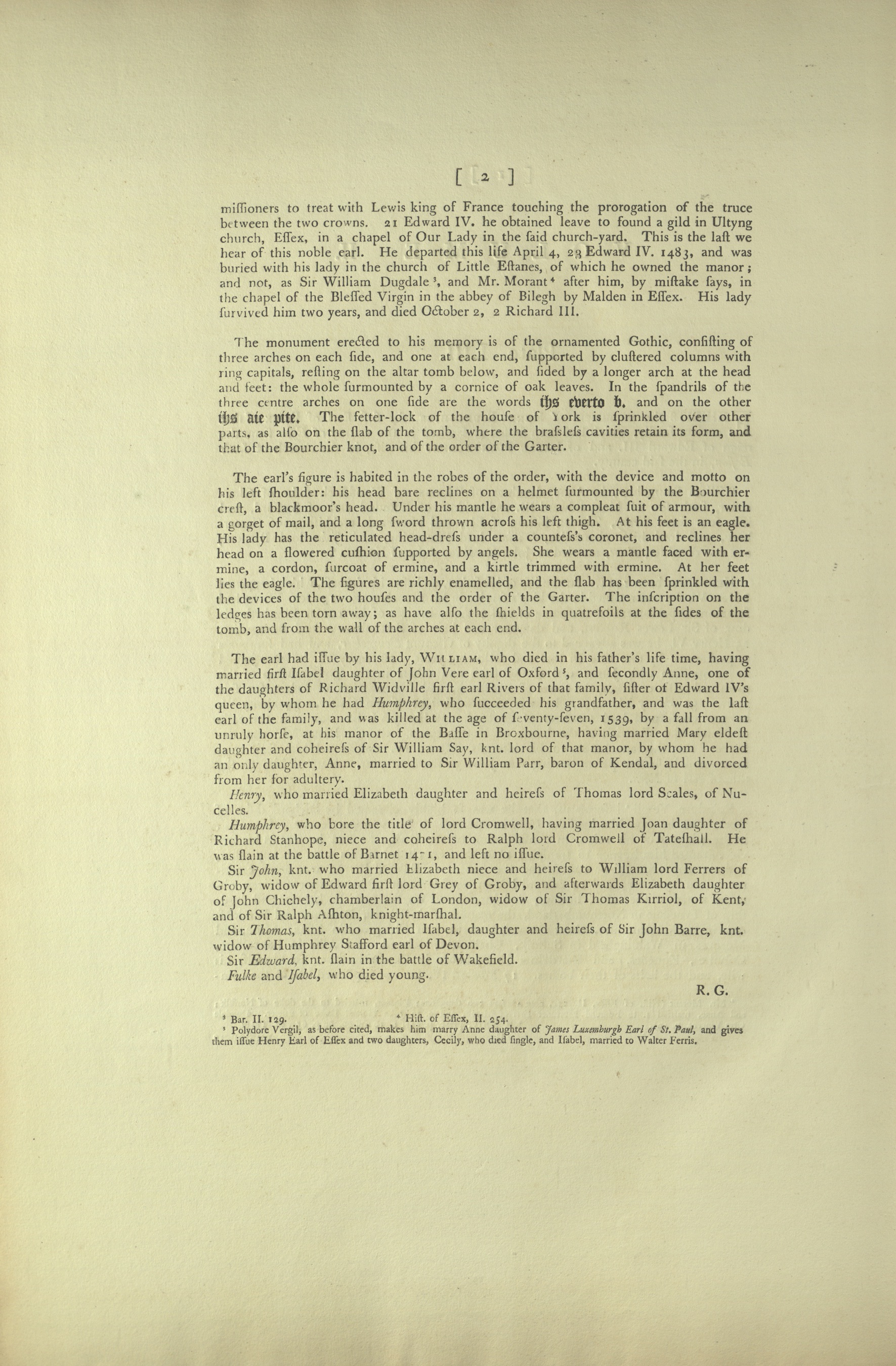[com-]missioners to treat with Lewis king of France touching the prorogation of the truce between the two crowns. 21 Edward VI. he obtained leave to found a gild in Ultyng church, Essex, in a chapel of Our Lady in the said church-yard. This is the last we hear of this noble earl. He departed this life April 4, 23 Edward IV. 1483, and was buried with his lady in the church of Little Estanes, of which he owned the manor; and not, as Sir William Dugdale3, and Mr. Morant4 after him, by mistake says, in the chapel of the Blessed Virgin in the abbey of Bilegh by Malden in Essex. His lady survived him two years, and died October 2, 2 Richard III.
The monument erected to his memory is of the ornamented Gothic, consisting of three arches on each side, and one at each end, supported by clustered columns with ring capitals, resting on the altar tomb below, and sided by a longer arch at the head and feet: the whole surmounted by a cornice of oak leaves. In the spandrils of the three centre arches on one side are the words ihs everto b. [translation here] and on the other ihs aie pite. [translation here] The fetter-lock of the house of York is sprinkled over other parts, as also on the slab of the tomb, where the brassless cavities retain its form, and that of the Bourchier knot, and of the order of the Garter.
The earl’s figure is habited in the robes of the order, with the device and motto on his left shoulder: his head bare reclines on a helmet surmounted by the Bourchier crest, a blackmoor’s head. Under his mantle he wears a compleat suit of armour, with a gorget of mail, and a long sword thrown across his left thigh. At his feet is an eagle. His lady has the reticulated head-dress under a countess’s coronet, and reclines her head on a flowered cushion supported by angels. She wears a mantle faced with ermine, a cordon, surcoat of ermine, and a kirtle trimmed with ermine. At her feet lies the eagle. The figures are richly enamelled, and the slab has been sprinkled with the devices of the two houses and the order of the Garter. The inscription on the ledges has been torn away; as have also the shields in quatrefoils at the sides of the tomb, and from the wall of the arches at each end.
The earl had issue by his lady, WILLIAM, who died in his father’s life time, having married first Isabel daughter of John Vere earl of Oxford5, and secondly Anne, one of the daughters of Richard Widville first earl Rivers of that family, sister of Edward IV’s queen, by whom he had Humphrey, who succeeded his grandfather, and was the last earl of the family, and was killed at the age of seventy-seven, 1539, by a fall from an unruly horse, at his manor of the Basse in Broxbourne, having married Mary eldest daughter and coheiress of Sir William Say, knt. lord of that manor, by whom he had an only daughter, Anne, married to Sir William Parr, baron of Kendal, and divorced from her for adultery.
Henry, who married Elizabeth daughter and heiress of Thomas lord Scales, of Nucelles.
Humphrey, who bore the title of lord Cromwell, having married Joan daughter of Richard Stanhope, niece and coheiress to Ralph lord Cromwell of Tateshall. He was slain at the battle of Barnet 1471, and left no issue.
Sir John, knt. who married Elizabeth niece and heiress to William lord Ferrers of Groby, widow of Edward first lord Grey of Groby, and afterwards Elizabeth daughter of John Chichely, chamberlain of London, widow of Sir Thomas Kirriol, of Kent, and of Sir Ralph Ashton, knight-marshal.
Sir Thomas, knt. who married Isabel, daughter and heiress of Sir John Barre, knt. widow of Humphrey Stafford earl of Devon.
Sir Edward, knt. slain in the battle of Wakefield.
Fulke and Isabel, who died young.
R[ichard]. G[ough].
3 Bar. II. 129.
4 Hist. of Essex, II. 254.
5 Polydore Vergil, as before cited, makes him marry Anne daughter of James Luxemburgh Earl of St. Paul, and gives them issue Henry Earl of Essex and two daughters, Cecily, who died single, and Isabel, married to Walter Ferris.


